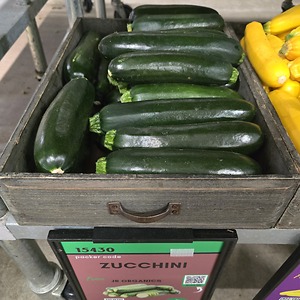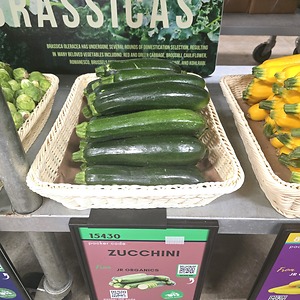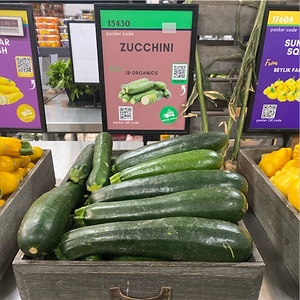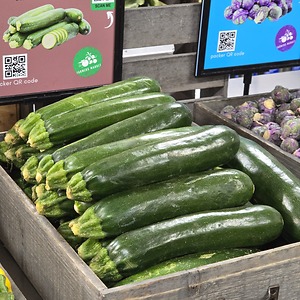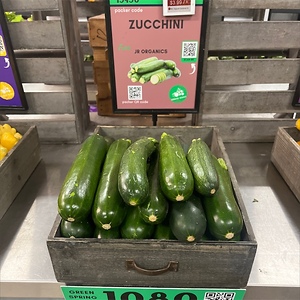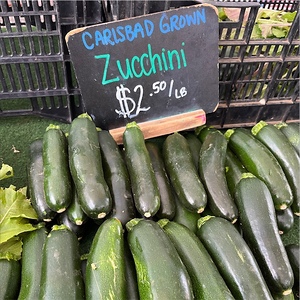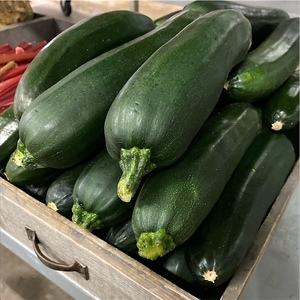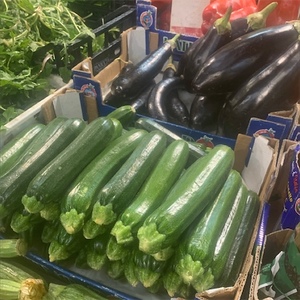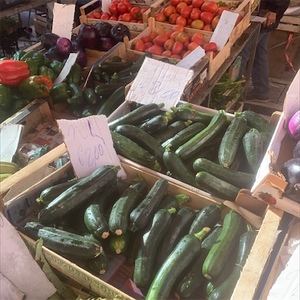

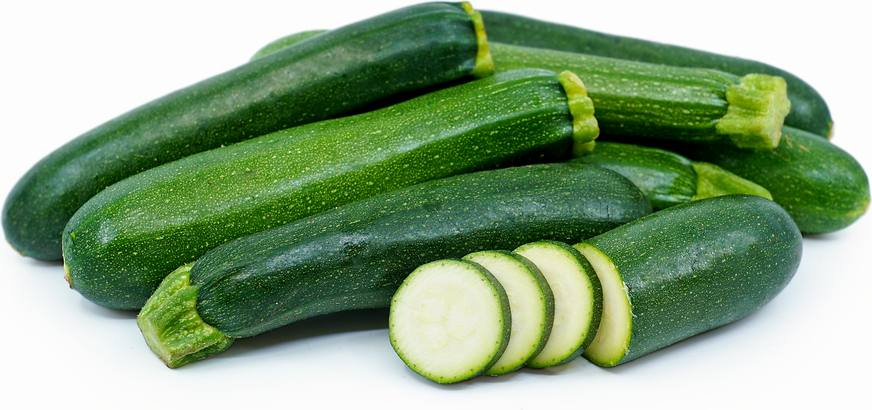
Green Zucchini Squash
Estimated Inventory, 18 lbs : 49.66
This item was last sold on : 07/10/25
Description/Taste
The Zucchini squash has a uniformly cylindrical shape with little to no taper from its stem to blossom end. It can be harvested when it is at its baby stage or when more mature at up to six to eight inches long. Many growers and chefs note that Zucchini will be at its peak flavor and texture when five to six inches in length. The exterior glossy skin of the Zucchini is vibrant to dark green in color and delicate enough to consume. Summer squash such as Zucchini are harvested when immature for best flavor, as a result their skin is delicate and prone to easily bruising and scratching. Its flesh is creamy white in color with a spongy yet firm texture and faint traces of edible seeds. It offers a sweet summer squash flavor with nuances of black peppercorn and nutty undertones. In addition to the fruit of the Zucchini plant the flower blossoms of Zucchini are also edible and offer a mild, squash like flavor.
Seasons/Availability
Originally grown as a summer vegetable, Zucchini squash is suitable to forced cultivation in temperate climates and is available for harvest year-round.
Current Facts
Zucchini is a classic summer squash and botanically a member of Cucurbita pepo. Today it is easily the most popularly grown and consumed of all summer squashes. There are numerous Zucchini varieties on the market today with independent names and characteristics. Zucchini can also be harvested at varying stages of maturity, when petite and at its baby stage of growth or when slightly more mature and medium sized. Fully mature Zucchini that are large with hardened skin have not developed much of a place in the commercial marketplace as their flavor and texture at this stage are not preferable for culinary applications. In the culinary context, Zucchini is treated as a vegetable. Botanically, however, the Zucchini is identified as the swollen fruit that stems from the female Zucchini flower.
Nutritional Value
Zucchini squash are a low caloric food and are nearly 94% water. Additionally they offer some vitamin A, vitamin C, calcium and iron.
Applications
Zucchini squash are mild in flavor, extremely versatile and can be prepared in sweet or savory recipes. Grate Zucchini and add squash to muffin or bread batter, or use to make vegetable pancakes and fritters. Thinly sliced Zucchini works well in salads or as part of a fresh (raw) appetizer such as vegetarian carpaccio. When sliced thinly lengthwise Zucchini squash can be an excellent substitute for conventional noodles in pasta preparations. Sliced Zucchini squash can be grilled, steamed, sautéed or battered and fried. Larger more mature squashes are perfectly sized for hollowing and baking when stuffed with meats, cheeses and grains. The Zucchini blossoms additionally can be stuffed with soft cheeses and herbs then battered and fried. The flavor and texture of Zucchini will complement a variety of ingredients such as tomatoes, garlic, corn, eggplant, fresh herbs such as parsley, basil and oregano, olive oil, pine nuts, eggs, citrus juice, sausage, roasted chicken and cheeses such as ricotta, mozzarella and parmesan. Zucchini squash will keep best when kept dry and refrigerated, for one to two weeks.
Ethnic/Cultural Info
The Zucchini squash may owe its parentage to Italy but its commercial success was one achieved in the United States, specifically Southern California’s Los Angeles where it was featured on the menu of the famous 1920’s restaurant Café Marcell and also made several appearances in food features of the Los Angeles Times.
Geography/History
While many summer squashes can trace their origins back to the early Americas Zucchini squash is believed to be native to Milan, Italy. Renowned squash historian Harry S. Paris notes the squash is a Milanese variety listed in an Italian seed pamphlet from 1901 for a squash named zucca quarantine vera nana. Zucchini would make its way to the United States via Italian immigrants around the time of World War I. Mention of the Zucchini can be found in American seed catalogs such as Los Angeles Germain Seed and Plant Co. where it was first listed as ”Italian squash” in 1918 then renamed in 1919 as Zucchini. The Zucchini caught on so quickly as a favorite squash of American growers and chefs that by 1920 the same catalog devoted a whole page to the now sought after Zucchini squash. Like many summer squash types when grown in mild to warm climates with ample sun exposure the Zucchini will be a highly prolific fruiter. So prolific in fact that August 8th is known as national sneak some zucchini onto your neighbor’s porch day, a nod to the overabundance of Zucchini many growers experience in the summer months.
Featured Restaurants
Restaurants currently purchasing this product as an ingredient for their menu.
| Brockton Villa Restaurant | San Diego CA | 858-454-7393 |
| C 2 C | San Diego CA | 619-972-9345 |
| US Grant Hotel Main | San Diego CA | 619-232-3121 |
| The Wild Thyme Company | San Diego CA | 858-527-0226 |
| Sheraton La Jolla | San Diego CA | 858-453-5500 |
| Pretty Pickled, Pretty Sauced | National City CA | 619-869-9921 |
| La Dona | San Diego CA | 858-352-8134 |
| Harney Sushi | San Diego CA | 619-295-3272 |
| Toast Cafe | San Diego CA | 858-208-9422 |
| Cliffhanger Cafe Menu | San Diego CA | 858-452-9858 |
| US Grant Hotel Grill | San Diego CA | 619-232-3121 |
| Crest Cafe | San Diego CA | 619-295-2510 |
| Cody's La Jolla | La Jolla CA | 858-459-0040 |
| The Local-Pacific Beach | San Diego CA | 858-263-7475 |
| Vista Valley | Vista CA | 760-758-2800 |
| The Guild Hotel | San Diego CA | 619-764-5108 |
| Tom Hams Light House | San Diego CA | 619-291-9110 |
| Cal A Vie | Vista CA | 760-945-2055 |
| Fishery | San Diego CA | 858-272-9985 |
| Coco Maya by Miss Bs | San Diego CA | 858-245-3780 |
| Lauberge Del Mar | Del Mar CA | 858-259-1515 |
| Love Boat Sushi-Oceanside | Oceanside CA | 760-721-3737 |
| Polaris Supreme | San Diego CA | 619-390-7890 |
| Sycuan Casino | El Cajon CA | 619-445-6002 |
| Kingfisher | San Diego CA | 619-861-8074 |
| Culinary Concepts | San Diego CA | 619-865-1918 |
| Kitchens For Good | San Diego CA | 619-450-4040 |
| Tartine | Coronado CA | 619-435-4323 |
| Rancho Santa Fe Golf Club | Rancho Santa Fe CA | 858-756-1582 |
| Sisters Pizza | San Diego CA | 858-228-6822 |
| Vinya: Vino & Vinyasa | San Diego CA | 858-703-8101 |
| Green Dragon Tavern & Museum | Carlsbad CA | 760-797-5579 |
| Joya Kitchen | San Diego CA | 619-255-5979 |
| Searcher Sportfishing | San Diego CA | 619-861-4640 |
| Pamplemousse Grill | Solana Beach CA | 858-792-9090 |
| Cocina de Barrio Point Loma | San Diego CA | 858-349-2313 |
| Le Parfait Paris | San Diego CA | 619-245-4457 |
| Humphrey's | San Diego CA | 619-224-3577 |
| Harumama Sushi & Ramen (Ocean Beach) | San Diego CA | 858-886-9909 |
| Little Frenchie | Coronado CA | 619-522-6890 |
| Mavericks Beach Club | San Diego CA | 858-999-0348 |
| Cardellino | San Diego CA | 619-722-3398 |
| Turf Supper Club | San Diego CA | 619-234-6363 |
| Marriott Gaslamp | San Diego CA | 619-696-0234 x6051 |
| Olive Tree Marketplace | San Diego CA | 619-224-0443 |
| Slowly | San Diego CA | 858-352-6080 |
| Brigantine Coronado | Coronado CA | 619-435-4166 |
| Park Hyatt Aviara | Carlsbad CA | 760-448-1234 |
| Nutmeg Bakery & Cafe 1 | San Diego CA | 858-405-2401 |
| Harumama Noodles & Buns (Vista) | Vista CA | 858-886-9909 |
| La Valle Coastal Club | Rancho Santa Fe CA | 858-759-5473 |
| Peace Pies (Encinitas) | Encinitas CA | 619-618-6960 |
| Trattoria I Trulli | Encinitas CA | 760-277-9826 |
| Huntress | San Diego CA | 619-955-5750 |
| The Roxy Encinitas | Encinitas CA | 760-230-2899 |
| Stone Brewing-Liberty Station | San Diego CA | 619-269-2100 |
| Sheraton Carlsbad (Banquets) | Carlsbad CA | 760-827-2400 |
| Southwestern Yacht Club | San Diego CA | 619-222-0438 |
| Parkhouse Eatery | San Diego CA | 619 295 7275 |
| Hane | San Diego CA | 619-339-6438 |
| Something Homemade | Vista CA | 858-245-1004 |
| Himitsu | La Jolla CA | 858-345-0220 |
| Kinme Omakase | San Diego CA | 619-231-0700 |
| Azuki Sushi Lounge | San Diego CA | 619-238-4760 |
| Daffodil Cafe | San Diego CA | 858-461-7788 |
| University Club | San Diego CA | 619-234-5200 |
| Casa | San Diego CA | 619-581-3003 |
| Scion Health | Escondido California | 442-277-6167 |
| Miguel's Old Town | San Diego CA | 619-298-9840 |
| Savory Moment (1) | Carlsbad CA | 619-633-8863 |
| Vulture / Dreamboat | San Diego CA | 858-342-3609 |
| Cove House | La Jolla CA | 858-999-0034 |
| The Flavor Chef (Catering) | Vista CA | 619-295-3172 |
| Viejas Casino TMDR | Alpine CA | 619-659-1774 |
| Miguel's Cocina Coronado | Coronado CA | 619-437-4237 |
| Bahia Resort Hotel | San Diego CA | 858-488-0551 |
| Sushi Kami | San Diego CA | 858-451-7799 |
| Jujus Kitchen | San Diego CA | 619-471-5342 |
| Duke's La Jolla | La Jolla CA | 858-454-1999 |
| Farmer and The Seahorse | San Diego CA | 619-302-3682 |
| Glenbrook Health Center | Carlsbad CA | 760-704-1000 |
| AKA | San Diego CA | 619-595-1450 |
| Marine Group Global Services LLC | San Diego CA | 619-972-9345 |
| Hilton Mission Valley | San Diego CA | 619-543-9000 |
| Isola Pizza Bar | San Diego CA | 619-564-2938 |
| Ju-Ichi | San Diego CA | 619-800-2203 |
| Sets Kitchen and Bar | San Marcos CA | 970-390-2148 |
| Juniper & Ivy | San Diego CA | 858-481-3666 |
| Hotel Republic San Diego | San Diego CA | 951-756-9357 |
| Mariahs Westwind Restaurant | San Marcos CA | 760-736-8108 |
| Park Commons - ARE | San Diego CA | 619-295-3172 |
| Parisien Gourmandises | La Jolla CA | 858-352-6552 |
| Third Corner Encinitas | Encinitas CA | 760-942-2104 |
| Giaola | Carlsbad CA | 858-266-9303 |
| Pacific Cafe & Catering (Medical Cntr Dr.) | La Jolla CA | 619-808-4087 |
| Culinary Kitchen Catering and Events | Coronado CA | 619-798-8477 |
| Wolf In the Woods | San Diego CA | 619-851-7275 |
| The Country Club Of Rancho Bernardo | San Diego CA | 858-487-1134 |
| Leila | San Diego CA | 619-550-5412 |
| Leucadia Pizza Scripps Ranch | San Diego CA | 858-530-2222 |
| Vi At La Jolla Village | San Diego CA | 858-646-7700 |
| Jo's Mission Hills Diner | San Diego CA | 619-417-3801 |
| Miguel's 4S Ranch | San Diego CA | 858-924-9200 |
| The Harvest Honey | San Marcos CA | 616-914-0124 |
| Fish & Things Poke Bar | San Diego CA | 916-995-1555 |
| The Glen at Scripps Ranch | San Diego CA | 858-444-8500 |
| Deeply Nourished | La Jolla CA | 808-489-7366 |
| Blue Ocean Sushi & Grill (UTC) | San Diego CA | 858-886-9909 |
| Georges at the Cove | San Diego CA | 858-454-4244 |
| Wrench and Rodent | Oceanside CA | 760-840-1976 |
| Justin Hoehn | San Diego CA | 619 326 8895 |
| Royal Polaris Sportfishing | San Diego CA | 619-226-8030 |
| Catamaran | San Diego CA | 858-488-1081 |
| Green Acres Campus | San Diego CA | 858-450-9907 |
| PureTaco | Carlsbad CA | 760-845-3346 |
| Higher Grounds Coffee + Cafe | San Diego CA | 831-247-5395 |
| Yoann Taboyan, Personal Chef | San Diego CA | 347-277-1958 |
| UCSD Health East campus | San Diego CA | 619-578-3373 |
| Pitchers | San Diego CA | 858-472-1251 |
| Small Barn | Temecula CA | 951-225-2822 |
| Salt & Whiskey | San Diego CA | 619-544-1886 |
| Peace Pies | San Diego CA | 619-618-6960 |
| Bayside Landing | San Diego CA | 858-270-9200 |
| The Farm Golf Club | Rancho Santa Fe CA | 858-756-5585 |
| The Santaluz Club Inc - Banquet | San Diego CA | 858-759-3150 |
| Mission Pacific | Oceanside CA | 760-450-7864 |
| Kona Kai Resort and Marina | San Diego CA | 619-221-8000 |
| Del Mar Country Club | Rancho Santa Fe CA | 858-759-5995 |
| Feast and Fareway | Coronado CA | 619-356-5444 |
| Inn at Rancho Santa Fe (Banquet) | Rancho Santa Fe CA | 858-381-8289 |
| Q&A Oyster Bar & Restaurant | Oceanside CA | 858-245-3780 |
| Solare Ristorante Lounge | San Diego CA | 619-270-9670 |
| Secret Sister | San Diego CA | 619-281-0718 |
| The Shores | La Jolla CA | 858-459-8271 |
| Portside Pier (Miguels) | San Diego CA | 858-268-1030 |
| Crust Pizzeria Solana Beach | Solana Beach CA | 858-212-8751 |
| Village Pizzaria | Coronado CA | 619-522-6890 |
| Continental Catering Inc | La Mesa CA | 907-738-9264 |
| Mister A's | San Diego CA | 619-239-1377 |
| Manhattan of La Jolla | La Jolla CA | 858-459-0700 |
| Cape Rey Carlsbad, a Hilton Resort | Carlsbad CA | 760-602-0800 |
| Barleymash | San Diego CA | 619-255-7373 |
| Shoreside Support Boat | San Diego CA | 704-277-7929 |
| Civico 1845 | San Diego CA | 574-210-4025 |
| Blue Ocean La Jolla | La Jolla CA | 858-999-0323 |
| Michele Coulon Dessertier | San Diego CA | 858-456-5098 |
| Maderas Golf Club | Poway CA | 858-451-8100 |
| Living Coast Discovery Center | Chula Vista CA | 619-409-5900 |
| Alexander's on 30th | San Diego CA | 858-774-3062 |
| Poseidon on the Beach | Del Mar CA | 858-755-9345 |
| Coin-Op Game Room (Downtown) | San Diego CA | 619-255-8864 |
| BFD-Big Front Door | San Diego CA | 619-723-8183 |
| Gravity Heights Mission Valley | San Diego CA | 619-384-5993 |
| Coast Catering | Escondido CA | 619-295-3173 |
| Four Seasons Residence Club | Carlsbad CA | 760-603-6360 |
| Make Stuff Good | San Diego CA | 949-547-9470 |
| Stake Chophouse & Bar | Coronado CA | 619-522-0077 |
| Belmont Park Draft | San Diego CA | 858-228-9283 |
| Surf Side Cuisine | San Diego CA | 619-507-0891 |
| Crown Point Catering | San Diego CA | 619-223-1211 |
| Public House 131 | San Diego CA | 858-537-0890 |
| Barbarella La Jolla | La Jolla CA | 858-454-7373 |
| Coronado Yacht Club | Coronado CA | 619-435-1848 |
| Miguel's Cocina Pt Loma | San Diego CA | 619-224-2401 |
| The Mission EV | San Diego CA | 619-232-7662 |
| Common Theory | San Diego CA | 858-384-7974 |
| Great Maple Hillcrest | San Diego CA | 619-255-2282 |
| Bridges at Rancho Santa Fe | Rancho Santa Fe CA | 858-759-6063 |
| Stout Public House | San Diego CA | 619-702-7933 |
| The Promiscuous Fork-La Jolla Blvd | La Jolla CA | 858-776-3246 |
| Farm Fresh Meals | Vista CA | 760-707-2383 |
| Leucadia Pizza Point Loma | San Diego CA | 619-295-2222 |
| Cocina De Barrio | San Diego CA | 760-840-1129 |
| The Barista Botanist | San Diego CA | 808-868-8639 |
| One Door North | San Diego CA | 858-232-4220 |
| Black Raill Kitchen + Bar | Carlsbad CA | 619-454-9182 |
| Fort Oak | San Diego CA | 619-795-6901 |
| Hilton Garden Inn | San Diego CA | 858-720-9500 |
| Crust Pizzeria Carlsbad 2019 | Carlsbad CA | 760-944-1111 |
| Chateau La Jolla | San Diego CA | 858-459-4451 |
| Ridgeview Health Center | San Diego CA | 858-293-3950 |
| Toast Catering | San Diego CA | 619-795-9135 |
| Ciccia Osteria | San Diego CA | 619-674-4069 |
| InterContinental San Diego | San Diego CA | 619-501-9400 |
| Flora Cafe | Bonita CA | 619-339-6604 |
| Pacific Coast Grill | Solana Beach CA | 858-794-4632 |
| Red O Restaurant (Bar) | San Diego CA | 858-291-8360 |
| Cocina de Barrio NP | San Diego CA | 858-349-2313 |
| La Jolla Country Club | San Diego CA | 858-454-9601 |
| Zanzibar at the Loft | La Jolla CA | 858-210-5476 |
| Cocina de Barrio Encinitas | Encinitas CA | 760-840-1129 |
| Blue Ocean | Carlsbad CA | 760-434-4959 |
| Pacific Yacht Agents | Los Angeles CA | 808-214-0970 |
| MCRD-Marine Corps Recruit Dept | San Diego CA | 619-725-6478 |
| Caffe Calabria Coffee Roasting Company | San Diego CA | 619-683-7787 |
| Giuseppe Restaurants & Fine Catering | San Diego CA | 619-436-7006 |
| The Mission NP | San Diego CA | 619-220-8992 |
| Casero Taqueria | Carlsbad CA | 760-533-4997 |
| Harney Poway Sushi | Poway CA | 760-533-0051 |
| Village Pizzeria Bay Side | Coronado CA | 619-522-6890 |
| Rabbit Hole | San Diego CA | 619-255-4653 |
| Brigantine Del Mar | Del Mar CA | 858-481-1166 |
| Mamas Kitchen | San Diego CA | 619-233-6262 |
| Rancho Valencia New Restaurant | Del Mar CA | 858-756-1123 |
| Fifty Two Remedies | San Diego San Diego | 858-707-7016 |
| InterContinental Vistal Kitchen | San Diego CA | 619-501-9400 |
| Prager Brothers Artisan Bread | Carlsbad CA | 760-445-9536 |
| Bali Hai Restaurant | San Diego CA | 619-222-1181 |
| Crafted @ Minerva's Cafe | La Jolla CA | 858-699-4129 |
| Sovereign Thai Cuisine | San Diego CA | 619-887-2000 |
| Nobu | San Diego CA | 619-814-4124 |
| Bencotto Italian Kitchen | San Diego CA | 619-822-5493 |
| Miguel's Cocina Carlsbad | Carlsbad CA | 760-759-1843 |
| Lodge at Torrey Pines Main | San Diego CA | 858-453-4420 |
| Sheraton Carlsbad (20/20) | Carlsbad CA | 760-827-2400 |
| The Original 40 Brewing | San Diego CA | 619-206-4725 |
| Villa Capri Poway | Poway CA | 858-391-9400 |
| Jake's Del Mar | Del Mar CA | 858-755-2002 |
| Solana Beach Kitchen | Solana Beach CA | 610-717-7217 |
| Piatti | San Diego CA | 858-454-1589 |
| Bernini's Bistro | La Jolla CA | 858-454-5013 |
| Saiko Sushi-Coronado | Coronado CA | 619-435-0868 |
| Ballast Point Rest. - Miramar | San Diego CA | 858-790-6900 |
| Bread & Cie Café | San Diego CA | 619-683-9322 |
| Smoking Gun | San Diego CA | 619-276-6700 |
| Nate's Garden Grill | San Diego CA | 619-607-0117 |
| Milton's Delicatessen, Grill & Bakery | Del Mar CA | 858-792-2225 |
| Oscars Brewing Company | Temecula CA | 619-695-2422 |
| Little Lion | San Diego CA | 619-519-4079 |
| Cutwater Spirits | San Diego CA | 619-672-3848 |
| UCSD Food & Nutrition Department La Jolla | San Diego CA | 858-761-1269 |
| Marys Gourmet Salads | La Jolla CA | 858-925-4690 |
| Urban Kitchen Catering | San Diego CA | 619-276-8803 |
| Siesel's Meats | San Diego CA | 619-275-1234 |
| The Santaluz Club Inc - Bistro Kitchen | San Diego CA | 858-759-3150 |
| Isola La Jolla | La Jolla CA | 858-412-5566 |
| Viewpoint Brewing Co. | Del Mar CA | 858-205-9835 |
| Mission Bay Yacht Club | San Diego CA | 858-488-0501 |
| Boujiemana | San Diego CA | 415-710-0510 |
| Harumama (Little Italy) | San Diego CA | 619-269-7122 |
| Saint Mark Golf and Resort, LLC | San Marcos CA | 508-320-6644 |
| insideOUT | San Diego CA | 619-888-8623 |
| Shogun Sportfishing | San Diego CA | 619-226-8030 |
| Coral Del Mar | Del Mar CA | 858-449-6679 |
| Ruth's Chris Steak House DT | San Diego CA | 619-233-1422 |
| Convention Center Shell | San Diego CA | 619-954-3063 |
| La Jolla Beach & Tennis Club | San Diego CA | 619-816-8319 |
| Fairmont Grand Del Mar | San Diego CA | 858-314-1975 |
| Il Giardino di Lilli | La Jolla CA | 619-467-9897 |
| Carte Hotel | San Diego CA | 619-365-1858 |
| Elks Lodge 2698 -Donation | Lakeside CA | 619-390-4949 |
| UCSD Food & Nutrition Department Hillcrest | San Diego CA | 619-380-9840 |
| Shimbashi Izakaya | Del Mar CA | 858-523-0479 |
| Sushi Ota 2021 | San Diego CA | 858-270-5047 |
| Firefly Beach | San Diego CA | 619-222-6440 |
| The Mission MB | San Diego CA | 858-488-9060 |
| Marriott Courtyard Old Town | San Diego CA | 619-260-8500 |
| Food by Chef Ty | Vista CA | 424-278-8626 |
| Reata Glen | Ladera Ranch CA | 949-545-2250 |
| Le Parfait Paris - Downtown | San Diego CA | 619-245-4457 |
| Luce | San Diego CA | 619-275-2094 |
| Snooze - La Jolla | La Jolla CA | 858-483-5556 |
| Mission Ave Bar and Grill | Oceanside CA | 760-717-5899 |
| PFC Fitness Camp | Carlsbad CA | 888-488-8936 |
| The Cottage La Jolla | La Jolla CA | 858-454-8408 |
| The Pearl Hotel | San Diego CA | 877-732-7573 |
| Burgo Direct | Chula Vista CA | 619-793-2325 |
| Peohes | Coronado CA | 619-437-4474 |
| Pacific Regent La Jolla | San Diego CA | 858-597-8008 |
| Lumi | San Diego CA | 619-955-5750 |
| Harumama Noodles & Buns (Carlsbad) | Carlsbad CA | 760-637-5737 |
| Nolita Hall | San Diego CA | 619-618-8820 |
| InterContinental Banquet Kitchen | San Diego CA | 619-501-9400 |
| San Diego Yacht Club | San Diego CA | 619-758-6334 |
| SIE Culinary Management | San Diego CA | 858-964-8677 |
| Jeune Et Jolie | Carlsbad CA | 858-231-0862 |
| Pizza Kaiju | San Diego CA | 619-240-2716 |
| Harumama Noodles & Buns (Encinitas) | Encinitas CA | 858-886-9909 |
Recipe Ideas
Recipes that include Green Zucchini Squash. One







